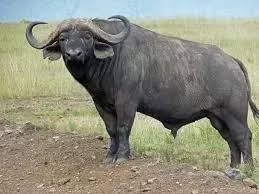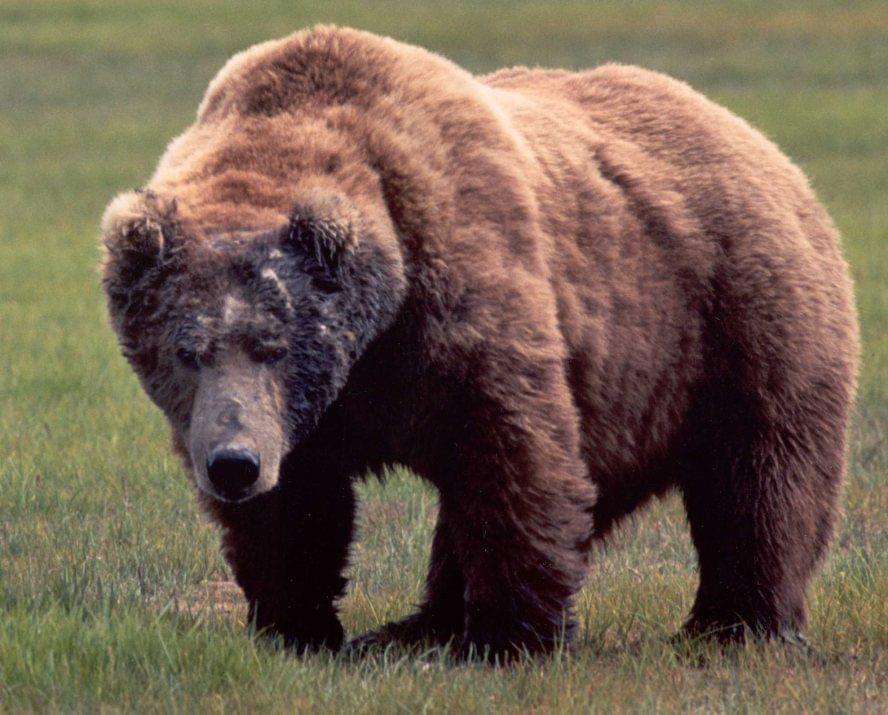Post by dinosauria101 on Feb 20, 2019 2:50:03 GMT 5
Grizzly Bear - Ursus arctos horribilis
The grizzly bear (Ursus arctos horribilis), also known as the silvertip bear, the grizzly, or the North American brown bear, is a subspecies of brown bear (Ursus arctos) that generally lives in the uplands of western North America. This subspecies is thought to descend from Ussuri brown bears which crossed to Alaska from eastern Russia 100,000 years ago, though they did not move south until 13,000 years ago. Except for cubs and females, grizzlies are normally solitary, active animals, but in coastal areas, the grizzly congregates alongside streams, lakes, rivers, and ponds during the salmon spawn. Every other year, females (sows) produce one to four young (commonly two) which are small and weigh only about 500 grams (1 lb). A sow is protective of her offspring and will attack if she thinks she or her cubs are threatened. The word "grizzly" in its name refers to "grizzled" or grey hairs in its fur, but when naturalist George Ord formally named the bear in 1815, he misunderstood the word as "grisly", to produce its biological Latin specific or subspecific name "horribilis". Most adult female grizzlies weigh 130–200 kilograms (290–440 lb), while adult males weigh 180–360 kilograms (400–790 lb), averaging 134 kg (295 lb) and 220 kg (485 lb), respectfully. The average total length in this subspecies is 198 centimetres (6.50 ft), with an average shoulder height of 102 centimetres (3.35 ft) and hindfoot length of 28 centimetres (11 in). Newborn bears may weigh less than 500 grams (1 lb). In the Yukon River area, mature female grizzlies can weigh as little as 100 kilograms (220 lb). On the other hand, an occasional huge male grizzly has been recorded which greatly exceeds ordinary size, with weights reported up to 680 kilograms (1,500 lb). Although variable from blond to nearly black, grizzly bear fur is typically brown in color with white tips. A pronounced hump appears on their shoulders; the hump is a good way to distinguish a black bear from a grizzly bear, as black bears do not have this hump.

African (Cape) Buffalo - Syncerus caffer
The African buffalo, affalo, nyati, Mbogo or Cape buffalo (Syncerus caffer) is a large African bovine. It is not closely related to the slightly larger wild Asian water buffalo, but its ancestry remains unclear. Owing to its unpredictable nature which makes it highly dangerous to humans, it has not been domesticated, unlike its Asian counterpart, the domestic Asian water buffalo. The Cape buffalo is a very robust species. Its shoulder height can range from 1 to 1.7 m (3.3 to 5.6 ft) and its head-and-body length can range from 1.7 to 3.4 m (5.6 to 11 ft). The tail can range from 70 to 110 cm (28 to 43 in) long. Savannah type buffaloes weigh 500 to 910 kg (1,100 to 2,000 lb), with males, normally larger than females, averaging 768 kg (1703 lbs). A record-sized savannah-type male weighed 1,000 kg (2,200 lb). Forest type buffaloes, at 250 to 455 kg (550 to 1,000 lb), are only half that size. Its head is carried low, its top located below the backline. The front hooves of the buffalo are wider than the rear, which is associated with the need to support the weight of the front part of the body, which is more powerful than the back.

Credit to Wikipedia
The grizzly bear (Ursus arctos horribilis), also known as the silvertip bear, the grizzly, or the North American brown bear, is a subspecies of brown bear (Ursus arctos) that generally lives in the uplands of western North America. This subspecies is thought to descend from Ussuri brown bears which crossed to Alaska from eastern Russia 100,000 years ago, though they did not move south until 13,000 years ago. Except for cubs and females, grizzlies are normally solitary, active animals, but in coastal areas, the grizzly congregates alongside streams, lakes, rivers, and ponds during the salmon spawn. Every other year, females (sows) produce one to four young (commonly two) which are small and weigh only about 500 grams (1 lb). A sow is protective of her offspring and will attack if she thinks she or her cubs are threatened. The word "grizzly" in its name refers to "grizzled" or grey hairs in its fur, but when naturalist George Ord formally named the bear in 1815, he misunderstood the word as "grisly", to produce its biological Latin specific or subspecific name "horribilis". Most adult female grizzlies weigh 130–200 kilograms (290–440 lb), while adult males weigh 180–360 kilograms (400–790 lb), averaging 134 kg (295 lb) and 220 kg (485 lb), respectfully. The average total length in this subspecies is 198 centimetres (6.50 ft), with an average shoulder height of 102 centimetres (3.35 ft) and hindfoot length of 28 centimetres (11 in). Newborn bears may weigh less than 500 grams (1 lb). In the Yukon River area, mature female grizzlies can weigh as little as 100 kilograms (220 lb). On the other hand, an occasional huge male grizzly has been recorded which greatly exceeds ordinary size, with weights reported up to 680 kilograms (1,500 lb). Although variable from blond to nearly black, grizzly bear fur is typically brown in color with white tips. A pronounced hump appears on their shoulders; the hump is a good way to distinguish a black bear from a grizzly bear, as black bears do not have this hump.

African (Cape) Buffalo - Syncerus caffer
The African buffalo, affalo, nyati, Mbogo or Cape buffalo (Syncerus caffer) is a large African bovine. It is not closely related to the slightly larger wild Asian water buffalo, but its ancestry remains unclear. Owing to its unpredictable nature which makes it highly dangerous to humans, it has not been domesticated, unlike its Asian counterpart, the domestic Asian water buffalo. The Cape buffalo is a very robust species. Its shoulder height can range from 1 to 1.7 m (3.3 to 5.6 ft) and its head-and-body length can range from 1.7 to 3.4 m (5.6 to 11 ft). The tail can range from 70 to 110 cm (28 to 43 in) long. Savannah type buffaloes weigh 500 to 910 kg (1,100 to 2,000 lb), with males, normally larger than females, averaging 768 kg (1703 lbs). A record-sized savannah-type male weighed 1,000 kg (2,200 lb). Forest type buffaloes, at 250 to 455 kg (550 to 1,000 lb), are only half that size. Its head is carried low, its top located below the backline. The front hooves of the buffalo are wider than the rear, which is associated with the need to support the weight of the front part of the body, which is more powerful than the back.
Credit to Wikipedia





